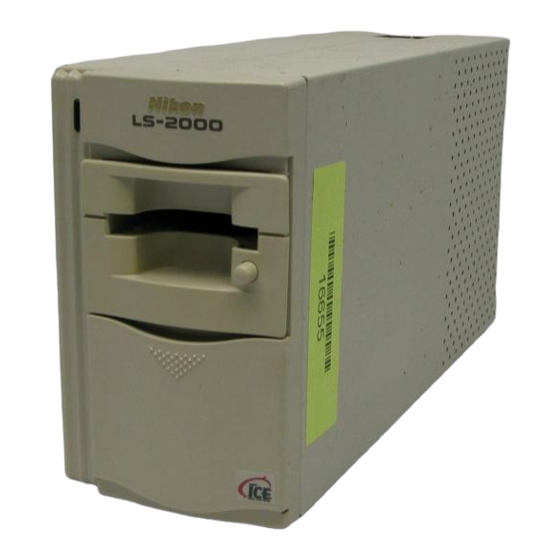
Nikon CoolScan LS-2000 Maintenance Service Manual
Hide thumbs
Also See for CoolScan LS-2000:
- User manual (47 pages) ,
- Reference manual (56 pages) ,
- Manual (2 pages)
Advertisement
Quick Links
Maintenance Service on Nikon CoolScan Slide Scanner
Summary: Major disassembly of scanner mechanism and controller circuit
board, lubricate and manually actuate slide rails and stepper motors.
Time to perform: about 2 hours
The X-axis scanning runs on three slide rails and a stepper motor. The Z-axis Autofocus runs on 2
slide posts, 2 forked sliders and a stepper motor. Both of these mechanisms require lube until they
move easily and smoothly. Circuit board removal is required as most of the mechanism to be lubed
is on the left side. Only one X-axis slide rail is accessible from the right side, making it an
incomplete job. Clean sensor lens and two front-sided mirrors, as needed.
Statement of Warranty, Limits of Liability agreement, and other WARNINGS is included in
Section IV, near the end of this document.
I. Qualify that the unit is operational, incoming inspection
0) check to see that no data cable is attached and that jacks are not damaged or contact pins are bent
or corroded.
1) make sure that unit turns on with just AC plugged in. See that green light turns on, blinks and
stays steady. Position unit in vertical position with power switch on top.
2) during the blinking phase, the unit is booting up and goes through mechanism qualification
steps, see if you can hear any buzzing where stepper motors are moving the scanner mechanism.
Testing of Autofocus is first and X-axis scan is second.
3) look inside the slide module throat and see if you can see any narrow strip of light from the LED
light module located in the upper case near where the inner edge of the slide mount would be.
Symptoms:
4) if any of the mechanisms doesn't move during the qualification step, the green light changes to a
rapid blink (about every half sec) and then steady green at the end of the boot sequence.
This negative failing rapid blink diagnostic will show up by the NikonScan app not recognizing
that a correctly booted scanner is attached...the infamous "Nikon Scan was unable to find any
active devices" dialog box message.
If yes to all four, then the unit just needs to be lubricated with Teflon and lens and mirrors cleaned
with alcohol and or aqueous lens cleaner.
5) if there is slow blinking (about once per second) during boot for about 15 sec and then a steady
green, then the slide scanner has booted normally and this maintenance and cleaning procedure is
not required at this time.
Advertisement

Summary of Contents for Nikon CoolScan LS-2000
- Page 1 (about every half sec) and then steady green at the end of the boot sequence. This negative failing rapid blink diagnostic will show up by the NikonScan app not recognizing that a correctly booted scanner is attached...the infamous "Nikon Scan was unable to find any active devices" dialog box message.
- Page 2 If the NikonScan app can't see a SCSI attached scanner, then usually the Windows computer needs the Adaptec ASPI driver installed too (in addition to the SCSI board AHA-2940 driver). II. Tools needed: 1) Set of jewelers screwdrivers, needs both flat bladed and Phillips tips. As a minimum, a set of 6 from Radio Shack $8-10 (Archer Japan) will do.
- Page 3 9) 8 1/2" x 11" notepad and PaperMate Write Bros pen with cap III. Disassembly and maintenance service procedure (this example is for Nikon Coolscan III, model LS-30 which has two MD-50 pin SCSI jacks, 1999 vintage) 0) remove all AC power and signal cables.
- Page 4 A) take out any transport screws from bottom of case and throat of slide carrier, where example MA-20 slide mount adapter fits into. Store them by screwing them in the back panel, threaded holes are just above the SCSI connectors. B) take off 4 screws on back panel, separate halves of metal case, and set aside, put in vial #1.
- Page 5 G) from the top, locate orange flexible ribbon cable and lift the left-edge locking mechanism delicately with a flat bladed screwdriver. Remove the flex ribbon cable and lube contacts and the jack’s locking mechanism with Teflon. H) separate circuit board from mechanism handling by the edges, inspect for dirt, corrosion, for any scratches or cracked board, and sniff for any burned part(s).
- Page 6 Fig 4. Right side of scanning mechanism, only one of three X-axis rails is visible, just under the upper tension spring. The LED light source assy on top and the CCD sensor assy is within the middle of sliding mechanism. The Z-axis Autofocus mechanism in the bottom between the two springs.
- Page 7 U) using a Q-tip or Texwipe swab and alcohol or lens cleaner, clean the mirrors and lenses as needed, inspect with a bright light. V) attach data cable when test computer is off, boot-up Nikon, then computer and test with NikonScan app with Preview scan and final Scan. Inspect scanned image for sharpness; night scenes with pin-point street lighting can be a good test subject.
- Page 8 X) Remove cables and re-attach case and four screws. Y) test again boot process and with NikonScan Z) test again a week later and / or burn-in for 48 hours Appendix A: (to remove the black mechanism assy from the metallic-colored case structural assy) This additional disassembly may be required to remove the top light source module to clean front surface mirrors, both on top and bottom where the lens and sensor module is.
- Page 9 V. Reference Major chips on circuit board, where this information is copyright by Nikon Corp, Tokyo, Japan. CoolScan is a registered trademark. LS-30 S/N are 258340, 233527, 246184 circuit board P/N F178045-1101-1 , components single-sided, mostly surface mount passive...







